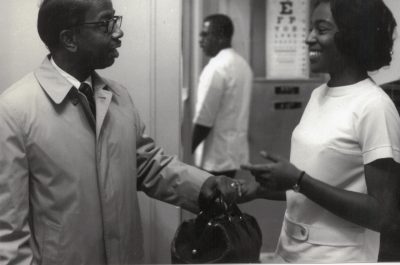An Ossining Cornerstone: The Legacy of Dr. George W. Hill
News Based on facts, either observed and verified directly by the reporter, or reported and verified from knowledgeable sources.
By Brian Kluepfel

A barking dog, a frightened visitor and the threat of an imminent canine incident startled Dr. George Hill from a sound sleep at his State Street home in Ossining one quiet night.
As a seasoned medical professional, Hill quickly triaged the situation, first removing the growling dog and then tending to his late-night patient. For the sake of his family’s peace of mind, it was time to separate his home and work lives, so the Hills decamped to neighboring Croton-on-Hudson.
Hill’s heart and offices, however, never left State Street, and on May 6 the corner at Academy Place was dubbed Dr. George W. Hill Street, an honor long overdue to a man who dedicated 40 years to the Ossining community’s health and welfare.
Hill was born in New York City in 1905 and moved with his family to Mount Vernon at three years old. He graduated from Mount Vernon High School, then to Cornell University. Inspired by a kind family physician, he studied at Indiana University Medical College, where one prejudiced professor continued to fail his papers until Hill had the gumption to scrawl his own grade atop one submission (he passed the class, eventually). He was the only Black student in the medical college.
Hearing that a Black doctor would not necessarily be welcome in Ossining, the indefatigable Dr. Hill – small of stature but mighty in resolve – stated, “In that case, I’ll come.”
Thus began a four-decade legacy of community service reaching far beyond his offices at 30 State St.
His first practice was on Croton Street; he then moved to Ossining’s historic Black district of Hunter Street, near the river. There he practiced alongside Black judges, pilots and other prominent members of the community. A neighboring hairdresser was even in the Green Book.
Described by Ossining Village Historian Joyce Sharrock Cole as “a small man with a big presence,” Hill was a true activist – a member of the Negro Elks, The Negro Civic Organization, the Alpha Phi Alpha fraternity (a holdover from his Indiana school days) and a prime mover in establishing the Cooperative Scholarship Fund at Ossining High School in 1963.
The first Black physician on staff at Ossining and Phelps hospitals, Hill was a pioneer in Westchester who creatively sought solutions. One Italian-American patient with a large family bartered landscaping services on Hill’s two properties in exchange for the doctor’s care of his brood.
Former patients vividly recall Hill’s unique bedside manner after returning from military service as a surgeon in the European theater during World War II: he would tend to patients while puffing a cigarette and tromping around the office in Army combat boots.
Renowned for his compassion and foresight beyond the office, Hill inspired Bernice Liddy to join his practice as a teen nurse. She later went on to form her own medical practice. He encouraged Donna Chambers, now an award-winning quiltmaker with works in the National Museum of African American History, to pursue her passion. Hill got Chambers her first job with his next-door neighbor, legendary textile designer Vera Neumann.
The building where Hill’s office was located was home to the town’s first Black dentist and Black female physician. His dream of a Black-staffed community health center did not come to fruition in his lifetime, but Ossining’s first Open Door Family Medical Center site was a clear tribute to his work with the underserved community.
“You can’t walk down the street without running into someone who knew him,” said Sharrock Cole. “They talk about him like he’s still alive.”
By 1968, Hill had 1,600 patients, half of whom were white. His dedication to causes like sickle cell anemia research was persistent; he set up the first local sickle cell clinics, boosting awareness rapidly.
“Suddenly everyone was a junior phlebotomist,” Sharrock Cole joked.
Contemporary racism slowed, but did not stop, Hill. His efforts to serve on the Ossining Board of Education were stymied, but he never stopped looking after his patients, even when their all-hours visits prompted the move to Croton. It was there that he tended to one of his more famous patients, playwright Lorraine Hansberry.
“Our African American population in Ossining in dwindling, and with that our sense of our history is dwindling too,” said Althema Goodson, an Ossining library trustee and Sharrock Cole’s partner in establishing the Dr. George R. Hill Legacy Center and naming the street for Hill.
“We had someone who fought for us,” she said. “Now that we understand the charge, we have to do it too.”
Hill’s former practice is part of Ossining’s “History in the Streets” audio tour, and the Legacy Center’s next task is stocking its library – in Hill’s original office – with the African American collection Hill curated at the Ossining Public Library.
His legacy looms large for Sharrock and Goodson, and although neither was born in Hill’s lifetime – he died in 1974 – they want to keep him alive for future generations.
“We’re taking his life and making it applicable today,” Goodson said. “If he could do it, why can’t the two of us?”

Examiner Media – Keeping you informed with professionally-reported local news, features, and sports coverage.
